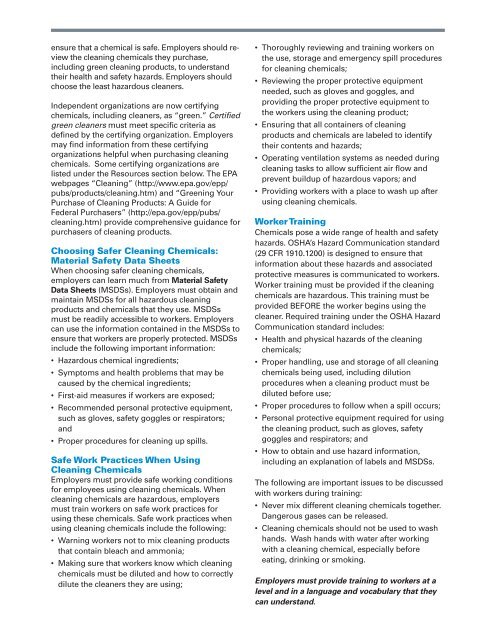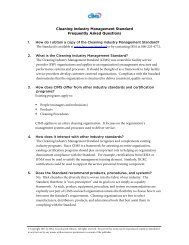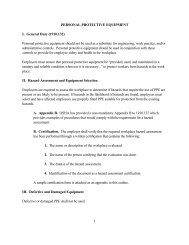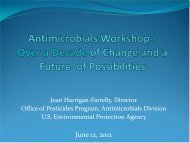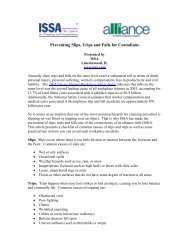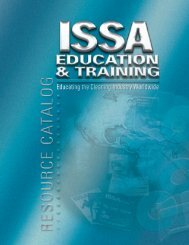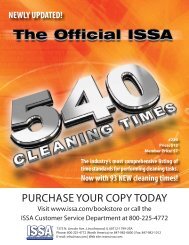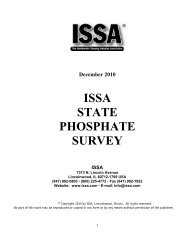Protecting Workers Who Use Cleaning Chemicals - OSHA
Protecting Workers Who Use Cleaning Chemicals - OSHA
Protecting Workers Who Use Cleaning Chemicals - OSHA
You also want an ePaper? Increase the reach of your titles
YUMPU automatically turns print PDFs into web optimized ePapers that Google loves.
ensure that a chemical is safe. Employers should review<br />
the cleaning chemicals they purchase,<br />
including green cleaning products, to understand<br />
their health and safety hazards. Employers should<br />
choose the least hazardous cleaners.<br />
Independent organizations are now certifying<br />
chemicals, including cleaners, as “green.” Certified<br />
green cleaners must meet specific criteria as<br />
defined by the certifying organization. Employers<br />
may find information from these certifying<br />
organizations helpful when purchasing cleaning<br />
chemicals. Some certifying organizations are<br />
listed under the Resources section below. The EPA<br />
webpages “<strong>Cleaning</strong>” (http://www.epa.gov/epp/<br />
pubs/products/cleaning.htm) and “Greening Your<br />
Purchase of <strong>Cleaning</strong> Products: A Guide for<br />
Federal Purchasers” (http://epa.gov/epp/pubs/<br />
cleaning.htm) provide comprehensive guidance for<br />
purchasers of cleaning products.<br />
Choosing Safer <strong>Cleaning</strong> <strong>Chemicals</strong>:<br />
Material Safety Data Sheets<br />
When choosing safer cleaning chemicals,<br />
employers can learn much from Material Safety<br />
Data Sheets (MSDSs). Employers must obtain and<br />
maintain MSDSs for all hazardous cleaning<br />
products and chemicals that they use. MSDSs<br />
must be readily accessible to workers. Employers<br />
can use the information contained in the MSDSs to<br />
ensure that workers are properly protected. MSDSs<br />
include the following important information:<br />
• Hazardous chemical ingredients;<br />
• Symptoms and health problems that may be<br />
caused by the chemical ingredients;<br />
• First-aid measures if workers are exposed;<br />
• Recommended personal protective equipment,<br />
such as gloves, safety goggles or respirators;<br />
and<br />
• Proper procedures for cleaning up spills.<br />
Safe Work Practices When Using<br />
<strong>Cleaning</strong> <strong>Chemicals</strong><br />
Employers must provide safe working conditions<br />
for employees using cleaning chemicals. When<br />
cleaning chemicals are hazardous, employers<br />
must train workers on safe work practices for<br />
using these chemicals. Safe work practices when<br />
using cleaning chemicals include the following:<br />
• Warning workers not to mix cleaning products<br />
that contain bleach and ammonia;<br />
• Making sure that workers know which cleaning<br />
chemicals must be diluted and how to correctly<br />
dilute the cleaners they are using;<br />
• Thoroughly reviewing and training workers on<br />
the use, storage and emergency spill procedures<br />
for cleaning chemicals;<br />
• Reviewing the proper protective equipment<br />
needed, such as gloves and goggles, and<br />
providing the proper protective equipment to<br />
the workers using the cleaning product;<br />
• Ensuring that all containers of cleaning<br />
products and chemicals are labeled to identify<br />
their contents and hazards;<br />
• Operating ventilation systems as needed during<br />
cleaning tasks to allow sufficient air flow and<br />
prevent buildup of hazardous vapors; and<br />
• Providing workers with a place to wash up after<br />
using cleaning chemicals.<br />
WorkerTraining<br />
<strong>Chemicals</strong> pose a wide range of health and safety<br />
hazards. <strong>OSHA</strong>’s Hazard Communication standard<br />
(29 CFR 1910.1200) is designed to ensure that<br />
information about these hazards and associated<br />
protective measures is communicated to workers.<br />
Worker training must be provided if the cleaning<br />
chemicals are hazardous. This training must be<br />
provided BEFORE the worker begins using the<br />
cleaner. Required training under the <strong>OSHA</strong> Hazard<br />
Communication standard includes:<br />
• Health and physical hazards of the cleaning<br />
chemicals;<br />
• Proper handling, use and storage of all cleaning<br />
chemicals being used, including dilution<br />
procedures when a cleaning product must be<br />
diluted before use;<br />
• Proper procedures to follow when a spill occurs;<br />
• Personal protective equipment required for using<br />
the cleaning product, such as gloves, safety<br />
goggles and respirators; and<br />
• How to obtain and use hazard information,<br />
including an explanation of labels and MSDSs.<br />
The following are important issues to be discussed<br />
with workers during training:<br />
• Never mix different cleaning chemicals together.<br />
Dangerous gases can be released.<br />
• <strong>Cleaning</strong> chemicals should not be used to wash<br />
hands. Wash hands with water after working<br />
with a cleaning chemical, especially before<br />
eating, drinking or smoking.<br />
Employers must provide training to workers at a<br />
level and in a language and vocabulary that they<br />
can understand.


